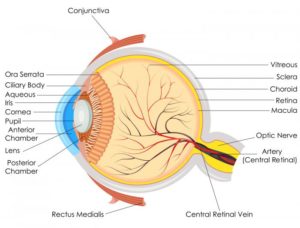 Eyes can say a lot about a person. These organs not only offer insight into a personality but can offer clues to the body’s overall health.
Eyes can say a lot about a person. These organs not only offer insight into a personality but can offer clues to the body’s overall health.
When the whites of the eyes turn yellow, it generally indicates that something is going on in the body that causes jaundice. Jaundice describes a yellowish tint to the skin and the whites of the eyes.
Excessively high levels of bilirubin in the blood cause jaundice. Bilirubin is a yellow waste substance found in bile, the liquid the liver makes to help break down fats.
When there is too much bilirubin in the bloodstream, it may leach into surrounding tissues like skin and eye tissues, causing them to yellow. Jaundice has different causes in adults, children, and newborns.
Contents of this article:
Anatomy of the eye
Causes of yellow eyes in newborns
Causes of yellow eyes in older children and adults
Anatomy of the eye
Jaundice mainly affects the front of the eye as this is where the yellow pigment would be visible.
A diagram of the eye.
A diagram of the eye. Jaundice is often seen in the sclera, iris, and eyelid.
It’s important to understand the anatomy of the front of the eye to understand how jaundice affects the eye. The front part of the eye is made of several different parts:
Eyelid and lashes: Upper and lower lids and lashes offer eyes protection from dirt and dust. They are also used to blink so the eyes stay moist. If jaundice is present, both the outer eyelids and the underside of the eyelid that is visible when the lid is lifted may have a yellow tint.
Pupil: The pupil is the dark center of each eye that controls the amount of light that enters. Generally, jaundice does not discolor the pupils.
Iris: The iris is the colored part of the eye immediately surrounding the pupils. It has muscles that contract the pupils. Yellowing may be seen in the iris if a person has jaundice.
Sclera: The whites of the eye. The sclera surrounds the iris and protects the fragile structures on the inside of the eye. Yellow eyes are often first noticed because the sclera yellows.
Causes of yellow eyes in newborns
Jaundice in newborns is very common because a newborn’s liver is still maturing. Bilirubin often builds up faster than a newborn’s immature liver can break it down, causing jaundice to occur frequently.
Aside from a yellowing of the skin, one of the clearest signs of jaundice in a newborn is the yellowing of the eyes.
A newborn baby with jaundice.
Jaundice is common in newborns as their livers are still developing.
Yellow eyes are only one symptom of newborn jaundice. New parents should also watch for the following symptoms:
Yellow skin
Lack of energy
Irritability
Fever
Trouble with eating
Any newborn with these symptoms should be checked immediately by a medical professional.
Most cases of newborn jaundice are harmless and resolve on their own as the baby’s liver matures.
Normal newborn jaundice causes include:
Physiological jaundice: Many newborns have this type of jaundice, due to the newborn’s still-developing liver. It normally appears when a baby is 2 to 4 days old.
Breastfeeding: Breastfeeding can cause jaundice when a baby isn’t getting enough breast milk to flush the bilirubin out. This type of jaundice often resolves when a mother’s milk comes in.
Breast milk: Occasionally, substances in breast milk cause a baby’s intestines to hold onto bilirubin rather than pass it through stool. This form of jaundice normally resolves itself by 12 weeks.
Some causes of newborn jaundice may be more concerning. These causes include:
Blood incompatibility jaundice: When a mother and baby don’t have compatible blood types, the mother’s body may attack the baby’s red blood cells while it is in the womb. As the mother’s antibodies are already breaking down the baby’s red blood cells before birth, this type of jaundice may present itself as early as 1 day old.
Jaundice of prematurity: Premature babies are at the greatest risk of jaundice because their livers are very immature. Premature babies may have more severe jaundice or jaundice alongside a number of other conditions.
Infections: Some bacterial infections like sepsis can cause a newborn to have jaundice.
Hemorrhage: Internal bleeding can cause jaundice. Premature babies are particularly at risk from hemorrhages.
While most cases of normal jaundice are mild to moderate, more severe newborn jaundice is possible. Cases of mild jaundice may resolve themselves while more moderate jaundice can be treated with light therapy.
Very severe cases may be treated with a blood transfusion. A pediatrician will be on the lookout for jaundice at a baby’s first checkup.
Causes of yellow eyes in older children and adults
In older children and adults, yellow eyes are always concerning because jaundice is not common in these age groups.
Unlike yellow skin, which may be from eating too many yellow and orange vegetables, yellow eyes are nearly always a sign of jaundice. Yellow eyes and jaundice in older children and adults normally indicate an underlying medical issue.
An adult with yellow eyes.
Yellow eyes in older children and adults often signal an underlying medical problem.
There are three main reasons for jaundice to occur:
Liver disease or liver injury: Liver problems cause a type of jaundice known as hepatocellular jaundice.
Breakdown of red blood cells: When red blood cells are broken down too quickly, there is an increase in bilirubin production.
A blockage in the bile duct system: When the tubes that carry the bile from the liver to the gallbladder and intestines get blocked, bilirubin can’t leave the liver and builds up excessively. This type of jaundice is called obstruction jaundice.
MNT DT






